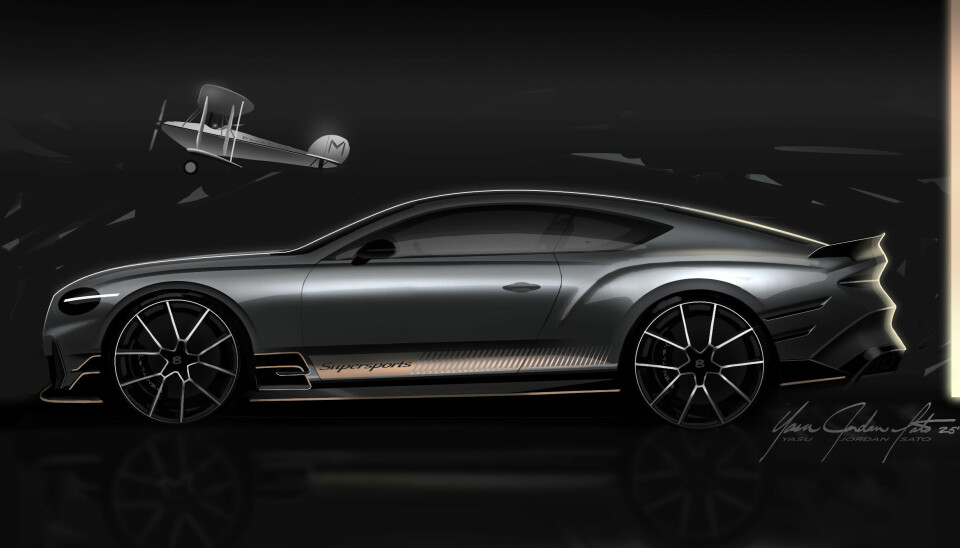Superlight Supersports
Don’t overlook the design of the Bentley Supersports

Bentley’s head of design shares some insight into the creation of the brand’s new lightweight Continental
It would be easy to focus on the numbers when it comes to Bentley’s fourth ever Supersports model. But don’t overlook the careful treatment of the exterior and interior design, which manages to combine extreme lightweighting with refined luxury.
The Continental name has been dropped for this project but it is indeed based on that GT car. As such, the fundamentals of the design remain the same, but radically-enhanced aerodynamics and a brutal approach to lightweighting has resulted in a menacing looking thing, more muscular and hunkered down than ever, dripping in carbonfibre.
At the front, a pair of canards now flick up and out from the corners of the bumper, reflected by similar aero work behind the front wheel arch. The front air intakes at either side of the lower mask are larger and more upright than the standard Continental GT, and to the rear, the boot spoiler is far more pronounced. Not quite duck tail, but not far off.
Bentley’s head of design Robin Page says that aerodynamics – or more specifically downforce – was a core focus for the project and prompted an even closer relationship with the aerodynamics team.
“We wanted every feature and surface change to be functional and purposeful,” he explains. “To achieve this, we worked hand-in-hand with the aerodynamics team and technical engineers to achieve the optimum downforces and weight reduction.”
Echoing the front of the car, a pair of indents sit on the rear quarter panel just behind the rear wheels. Quad exhaust tips remain, although in this case they are much brighter and jump out from the dark grey bodywork and carbon rear diffuser. That full length titanium exhaust system comes courtesy of Akraprovic. A prominent ‘8’ can be seen in the black mesh grille up front, a tribute to the story of pilot, powerboat racer and driver Mildred Mary Petre, and the Bentley bonnet badge features blacked out wings.
Importantly, the feeling of the sketches put together by Ilya Razumov and Yasu Jordan Sato have translated well into production. “The great thing about Bentley is the spirit of the team and the enthusiasm to come up with ideas outside of the existing product plan,” says Page. “This project was born with a few early sketches and an engineering mock up. Once agreed with the board, the team executed quickly, with the project taking around a year from early ideas to launch.”
Elsewhere, hulking 22” forged wheels come from Manthey Racing (a supplier to Porsche DTM race cars) and feature a five- or ten-spoke design depending on your definition: five main blocks stem from the hub at the centre before splitting into two blades each. We do not have a stat for the rear tyres, but there is considerable girth to those Pirelli Trofeo RS treads.

Inside, the architecture of the cabin remains but the surfaces might feel a little different in places owing to lighter, more ‘performance-oriented’ materials. Overall, it still feels very much up to standard with what Bentley drivers would expect. A plaque mounted below the engine start button gives a unique one-of-500 designation to each vehicle.
The rear seats have been thrown out altogether, and the seats that do remain up front have been mounted lower in the car. Because race car. What remains is finished to the same standard as the main cabin with carbonfibre, Dinamica fabric and leather. It does not feel like a budget track car that has been stripped to the bare metal. This is partly why the interior still feels like a Bentley.
“Most of the weight reduction for the interior came from removing the two rear seats and replacing them with carbon fibre panels and open storage,” explains Page. “We also reduced the weight in the front seats, while still creating beautiful, hand-crafted seats as expected of any Bentley.”
How about those figures, though. A menacing 666PS (656bhp) comes from a twin-turbo 4.0-litre V8, this time offered without hybrid assistance. The carbonfibre aero work combine to add 300kg more downforce than the standard car, and all in, the car weighs less than two tonnes.
As for elements of the design that might go underappreciated for the level of effort that went in, Page refers to some of the painted graphics and pin stripe edging applied to the carbonfibre.
“We have an extremely high standard in terms of surface finish, meaning we do not just put transfers on the surface but instead ensure any graphic work is under the lacquer and smooth to the touch,” he says. “The choice of personalisation inside and out for this limited run of 500 cars is insane.”
































